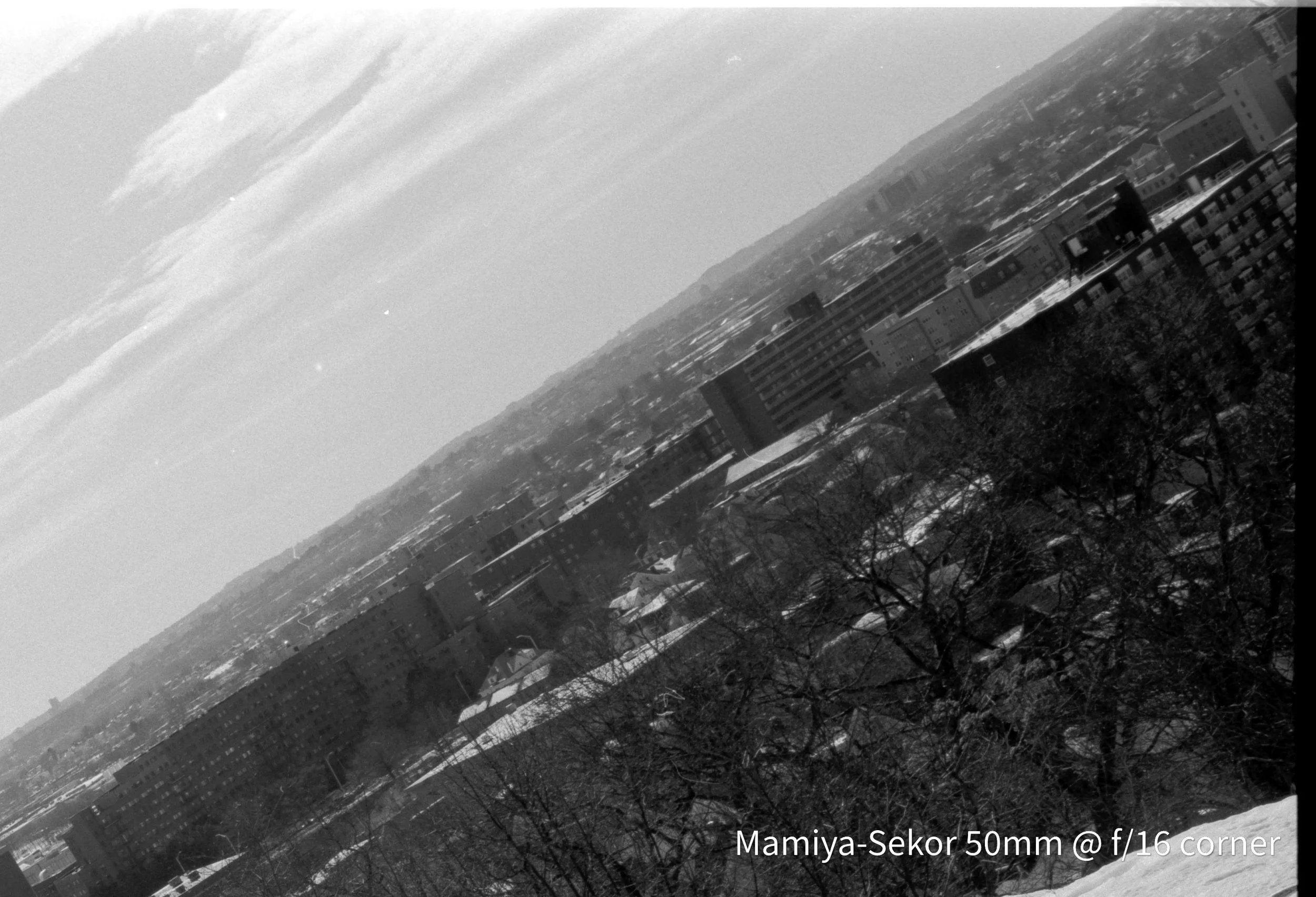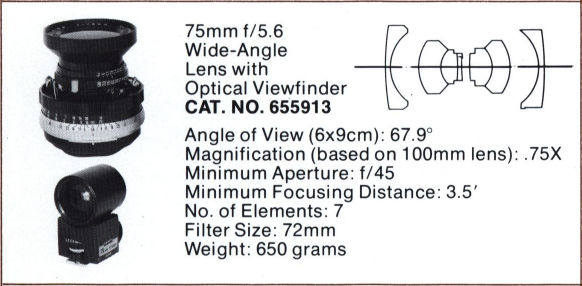Mamiya Press Lens Comparison: 50mm, 65mm, 75mm, 100mm
Hello again everyone! Its time to take a look at some of the lens options on the Mamiya Press. There’s a good amount of information online about these lenses and bodies, I would like to spend some time taking a look at their optical layouts and some of the performance you can expect out of them!
The lenses that I currently own and am going to include in this review:
Mamiya 50mm f/6.3 (21mm equivalent) (Seiko #0)
Mamiya 65mm f/6.3 (28mm equivalent) (Seikosha-S)
Mamiya 75mm f/5.6 (32mm equivalent) (Seiko #0)
Mamiya 100mm f/2.8 Chrome Version (43mm equivalent) (Seikosha-S)
All of the lenses I own seem to be single coated. Each one has its own built in shutter providing flash sync throughout the whole range, earlier chrome lenses have Seikosha-S shutters and later lenses have Seiko #0 shutters. All shutters provide the same range of speeds from 1 second to 1/500th of a second. Each lens has 5 aperture blades and depending on the lens version, will either be controllable smoothly without clicks or will have click stops for each of the aperture settings. Each lens is a little different in configuration and interface so its important to make sure you know how to operate each one as you can easily accidentally expose your film if you leave the shutter open or fire it during the wrong moment.
The 50mm, 65mm and 75mm do not have framelines in the viewfinder and therefore require an external viewfinder for framing or using the ground glass attachment. The 50 and 75mm viewfinders have reflected framelines and marks for 6x7 and 6x9 but the 65mm only has small marks and no framelines. All the external viewfinders offer manual parralax correction and can be mounted on the cold shoe. The lenses are rangefinder coupled and the standard viewfinder can be used in conjunction with the external one for focus checking. The Super 23 camera I have has frame lines for the 100mm, 150mm and 250mm lenses, and also offers parallax correction when focusing.
Mamiya-Sekor 50mm f/6.3
Specs of the 50mm f/6.3 From Mamiya Press Brochure
With a very Biogon-esque looking optical layout and 8 elements in 5 groups, the Mamiya 50mm f/6.3 is the widest lens for the press system, and one of the wider lenses that can cover 6x9. The design of the Press system allows for lenses to sit very close to the film plane, and allows for some nicely designed symmetrical lenses. In theory, this should mean low distortion and allows lens designers more versatility in the design as they are not as limited by the longer flange distance of many slr cameras. This lens is not very fast at f/6.3, but since it is so wide its really more intended for landscapes and architecture in which you would be stopping down more anyways. Speaking of which, the lens stops down to f/32 which should give enough dof for most applications. The front lens is a bit bulbous and a lens hood is recommended to try and cut some of the flaring out (especially since this lens is single coated). The lens features its own shutter button and separate mounting for a release cable that is different than the other lenses in the system. It is a bit bulky when not mounted but when mounted the rear part of the lens sits inside the camera body and balances nicely with the cameras and backs.
Focus is done using the small focusing knob on the lens, the shutter speeds are selected on the front of the lens and the aperture using a small knob to turn the aperture ring. The lens features its own locking shutter button instead of the usual shutter release lever found on the others in the system. To lock the shutter in bulb mode, one must push in the shutter button and twist, locking it in place. This is how you would focus the lens on the ground glass attachment, just remember to close the shutter again before placing the film back on and removing the dark slide.
50mm at Top: f/6.3, Middle: f/16, Bottom: f/32: Scanned on a V850 with Silverfast, sharpened in Lightroom and adjusted to look similar exposure wise
Mamiya-Sekor 65mm f/6.3
Specs of the 65mm f/6.3 From Mamiya Press Brochure
Not as wide as the larger and heavier 50mm, this lens is absolutely tiny in comparison with the other lenses in the lineup. It topogon design can be thanked for that, with only 4 elements in 4 groups, it allows the lens to be compact and small. The downside is the slightly “slow” wide open aperture of f/6.3 in which you can see the 5 aperture blades even when the lens is “wide open”. This lens can be modified to open up to around f/4 but the image quality is not very useable, I am assuming the opening on the Seikosha-S shutter is too large which pushes the optical design past its limits (which is why even wide open you can see the aperture blades).
65mm f/6.3 modified to open to about @ f/4.5ish
Being small and light is not a compromise of image quality, topogon lenses are known for their very low distortion and good sharpness, they just tend to be slower by the nature of their design. This lens features a similar focusing knob like on the 50mm, but has a shutter lever instead of the button. The shutter lever can be locked to allow focusing in B mode, and opposite the lever is an attachment for a shutter release cable. Shutter speeds are changed on the chrome ring found on the front of the shutter, and aperture is changed by moving a small metal lever to the desired spot. Handling on this lens is a bit finnicky because of its small size and the lens shutter sits a little recessed in the housing. The front element is bulbous but small, and it sits recessed allowing the filter holder and baffles to almost act as a sort of small hood. This lens is single coated and the optical layout and coating is the same, there is only a chrome version of this lens. The lens viewfinder can be found in silver or black.
65mm at Top: f/6.3, Middle: f/16, Bottom: f/32
65mm @ First: f/11, Second: f/16, Third: f/22, Last: f/32
Mamiya-Sekor 75mm f/5.6
Specs of the 75mm f/5.6 From Mamiya Press Brochure
Getting closer to a more “standard” lens while still being a bit wide is the 75mm f/5.6. This lens has great coverage even past 6x9 and can be used for Polaroid Pack film as well. (This lens and the 127mm are the two lenses for this system that were designed to shoot Polaroid on the Mamiya Universal with the appropriate back). With 7 elements in 4 groups and a “super-angulon” esque design and great coverage, in theory this should result in some low distortion and low vignetting. The rear element is large but is not a full circle and has a cut in it. The front element is pretty flat and the lens takes 72mm filters, the same as the 50mm. This lens stops down to f/45, one more stop compared to the 50mm and 65mm which can help in landscape photography. This lens has a similar viewfinder to the 50mm lens, but with an extra frameline for polaroid film. This lens weighs a little more than the 50, but features a more standard focusing helicoid grip instead of a tab, and also features a way to open and close the shutter for viewing while it is cocked that does not require using the B mode. There is a lever you can flip once the shutter is cocked and it will open the blades up or close them back.
75 @ First: f/11, Second: f/22, Third: f/32, Fourth: f/45
Specs of the 100mm f/2.8 From Mamiya Press Brochure
There are multiple “standard” lenses for the press but this is the “premium” one for the system. Boasting a maximum aperture of f/2.8 this lens is quite fast for 6x9. In 35mm terms, this lens is equivalent to about a 43mm f/1.2 which gives a slightly wider standard lens but very shallow dof wide open. This lens is sharp throughout its range and you can see in the sample images that the characteristics of its bokeh is very nice (probably due to its double-gauss/planar-esque design).
100 @ First: f/2.8, Second: f/11, Third: f/32
100 @ First: f/11, Second: f/16, Third: f/22, Fourth: f/32



































